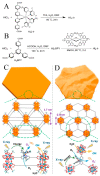Biodegradable Metal Organic Frameworks for Multimodal Imaging and Targeting Theranostics
- PMID: 34562889
- PMCID: PMC8465391
- DOI: 10.3390/bios11090299
Biodegradable Metal Organic Frameworks for Multimodal Imaging and Targeting Theranostics
Abstract
Though there already had been notable progress in developing efficient therapeutic strategies for cancers, there still exist many requirements for significant improvement of the safety and efficiency of targeting cancer treatment. Thus, the rational design of a fully biodegradable and synergistic bioimaging and therapy system is of great significance. Metal organic framework (MOF) is an emerging class of coordination materials formed from metal ion/ion clusters nodes and organic ligand linkers. It arouses increasing interest in various areas in recent years. The unique features of adjustable composition, porous and directional structure, high specific surface areas, biocompatibility, and biodegradability make it possible for MOFs to be utilized as nano-drugs or/and nanocarriers for multimodal imaging and therapy. This review outlines recent advances in developing MOFs for multimodal treatment of cancer and discusses the prospects and challenges ahead.
Keywords: biodegradable materials; metal ion nodes; metal-organic framework; multimode imaging; theranostic nano-platforms.
Conflict of interest statement
The authors declare no conflict of interest.
Figures










Similar articles
-
Stimuli-Responsive Design of Metal-Organic Frameworks for Cancer Theranostics: Current Challenges and Future Perspective.ACS Biomater Sci Eng. 2023 Aug 14;9(8):4497-4526. doi: 10.1021/acsbiomaterials.3c00507. Epub 2023 Aug 1. ACS Biomater Sci Eng. 2023. PMID: 37526605 Review.
-
Core-shell inorganic NP@MOF nanostructures for targeted drug delivery and multimodal imaging-guided combination tumor treatment.Adv Colloid Interface Sci. 2023 Nov;321:103007. doi: 10.1016/j.cis.2023.103007. Epub 2023 Sep 25. Adv Colloid Interface Sci. 2023. PMID: 37812992 Review.
-
Advances in the use of MOFs for Cancer Diagnosis and Treatment: An Overview.Curr Pharm Des. 2020;26(33):4174-4184. doi: 10.2174/1381612826666200406153949. Curr Pharm Des. 2020. PMID: 32250216 Review.
-
Metal-Organic Frameworks for Biomedical Applications.Small. 2020 Mar;16(10):e1906846. doi: 10.1002/smll.201906846. Epub 2020 Feb 6. Small. 2020. PMID: 32026590 Review.
-
Metal-organic frameworks: a biomimetic odyssey in cancer theranostics.Nanoscale. 2025 May 23;17(20):12620-12647. doi: 10.1039/d5nr00794a. Nanoscale. 2025. PMID: 40336407 Review.
Cited by
-
Ultra-Small and Metabolizable Near-Infrared Au/Gd Nanoclusters for Targeted FL/MRI Imaging and Cancer Theranostics.Biosensors (Basel). 2022 Jul 24;12(8):558. doi: 10.3390/bios12080558. Biosensors (Basel). 2022. PMID: 35892455 Free PMC article.
-
Application of MOF-based nanotherapeutics in light-mediated cancer diagnosis and therapy.J Nanobiotechnology. 2022 Sep 24;20(1):421. doi: 10.1186/s12951-022-01631-2. J Nanobiotechnology. 2022. PMID: 36153522 Free PMC article. Review.
-
Advances of medical nanorobots for future cancer treatments.J Hematol Oncol. 2023 Jul 14;16(1):74. doi: 10.1186/s13045-023-01463-z. J Hematol Oncol. 2023. PMID: 37452423 Free PMC article. Review.
-
Engineering functionally-optimized aptamers against SARS-Cov-2 for blocking spike-ACE2 interaction and aptasensor detection.Mater Today Bio. 2025 Jun 23;33:102020. doi: 10.1016/j.mtbio.2025.102020. eCollection 2025 Aug. Mater Today Bio. 2025. PMID: 40642289 Free PMC article.
-
Recent Advances in Nanotechnology-Based Approaches for Ferroptosis Therapy and Imaging Diagnosis in Pancreatic Cancer.Pharmaceutics. 2025 Jul 20;17(7):937. doi: 10.3390/pharmaceutics17070937. Pharmaceutics. 2025. PMID: 40733146 Free PMC article. Review.
References
-
- Allmani C., Matsuda T., Di Carlo V., Harewood R., Matz M., Niksic M., Bonaventure A., Valkov M., Johnson C.J., Esteve J., et al. Global surveillance of trends in cancer survival 2000–14 (CONCORD-3): Analysis of individual records for 37 513 025 patients diagnosed with one of 18 cancers from 322 population-based registries in 71 countries. Lancet. 2018;391:1023–1075. doi: 10.1016/S0140-6736(17)33326-3. - DOI - PMC - PubMed
Publication types
MeSH terms
Substances
Grants and funding
- 82061148012/National Natural Science Foundation of China
- 82027806/National Natural Science Foundation of China
- 91753106/National Natural Science Foundation of China
- 2017YFA0205300/the National Key Research and Development Program of China
- BE2019716/Primary Research & Development Plan of Jiangsu Province
LinkOut - more resources
Full Text Sources
Medical

